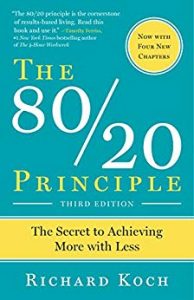 I’ve written about this before, but I’m always amazed at how deep you can go into any one genre or subject when reading. Here’s a case in point. I like to read personal improvement books, especially those that help me set priorities, get things done, and, on the whole, manage myself better. I’d have to go pretty far back to find the first book I read on the topic, but the genre only seems to get deeper and wider the more books I read in it. Whether it’s exploring other books by the same author, references to other books embedded in the ones I’m reading, recommendations by friends, families, or blogs I follow, or my ultimate nemesis, the Amazon recommendation engine, the quantity of books that I can read on the subject never ends.
I’ve written about this before, but I’m always amazed at how deep you can go into any one genre or subject when reading. Here’s a case in point. I like to read personal improvement books, especially those that help me set priorities, get things done, and, on the whole, manage myself better. I’d have to go pretty far back to find the first book I read on the topic, but the genre only seems to get deeper and wider the more books I read in it. Whether it’s exploring other books by the same author, references to other books embedded in the ones I’m reading, recommendations by friends, families, or blogs I follow, or my ultimate nemesis, the Amazon recommendation engine, the quantity of books that I can read on the subject never ends.
It should be no surprise then that I happened upon The 80/20 Principle: The Secret to Achieving More with Less by Richard Koch. I added the book to my reading list after I saw it referenced in Ninja Selling by Larry Kendall. I’ve found that when a book you really like makes reference to other books, you generally can’t go wrong reading them.
The 80/20 Principle, also widely known as the Pareto Principle, was not discovered by Koch, and it isn’t a recently introduced concept. The principle first appeared in the early 1900’s when an Italian economist discovered that 80% of the wealth in Italy was controlled by 20% of the population. The economist’s name was Vilfredo Pareto, and hence, the principle’s name. Since that time, the 80/20 principle has been found to apply to many other phenomena and can be generally defined as follows: A minority, or 20% of causes, inputs, or effort, lead to a majority, or 80% of the results, outputs, or rewards.
Pareto’s Principle is also referred to as the Law of the Vital Few. Why? Because it is the few that are largely and overwhelmingly responsible for the majority of success. And that’s where Koch’s insight comes into play. He provides example after example and shows how you can apply the 80/20 Principle to your business, your work habits, your career, and your personal life to achieve more success with less effort by focusing on the items that provide the most leverage. Obviously, since each of our situations is different, Koch doesn’t have specific answers for us, but he does provide strategies for identifying what those high leverage items might be.
Overall, The 80/20 Principle is a solid read, but not one of my Must Reads. There are a lot of strong concepts and strategies that can be taken from the book. Personally, I picked up a few new items, but it was mostly a book that reinforces and collects, in one place, a lot of concepts and ideas that I’ve already been exposed to. The key for me is applying these concepts and putting them into practice as part of my daily habits. I suppose it’s one of those things that I will always be working on
It’s so easy to get distracted and lose sight of what’s important, especially with all the distractions that are present in our modern world. Just like we shower daily, exercise daily, regularly watch what we eat, and keep our living space tidy, we also need to consistently reinforce and remind ourselves of what’s most important in our lives. The 80/20 Principle is a good book that will provide you with both the motivations and strategies to do just that.

Pingback: My 2018 reading list - Gregg Borodaty